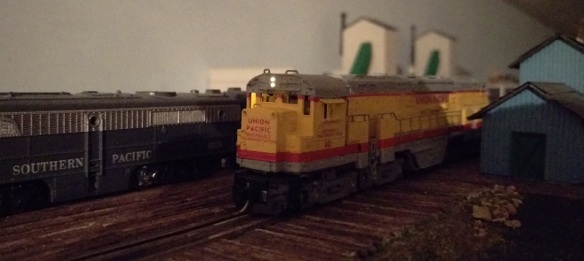This week I have moved my C-855 project on a little bit further by adding lights to the locos so in this week’s post I will show you how I did it.
As with any modeling project there are several ways to do the same thing but this method works for me. The C-855 has a pair of headlights centered above the cab windows, one above the other.

There is also a rear facing light, offset on the right hand side, but I have chosen not to illuminate this because these C-855s will always be running together so the rear lights would never come on.
When I made the 3D model I allowed room in the cab roof for an LED; I even recessed the roof to accept a 2mm LED directly into the back of the light as you can see in the section image below.

However, for this particular loco I used an LED from a DC lighting board. Having used lots of Atlas C-628 & C-630 chassis for my DT6-6-2000 & RT-624 projects I have several of these boards knocking about.

There are a few reasons for using these. The LED is the right color, there is a resistor already attached and the LED is shrouded by a rubber sleeve. This LED is a 3mm so it won’t fit into the hole I designed in the roof but I’ll deal with that later.
The only parts of the lighting board I really need are the LED and resistor; and only one end has these close together. Using a pair of side snips I cut off that end just behind the yellow capacitor.

Then I cut the resistor leg furthest from the LED and rotate the resister by 90 degrees.

Then, to make access a bit easier, I remove the capacitor and diode from the circuit board.

Lastly I cut the unnecessary part of the circuit board away, leaving me with just the parts I need.

The inside of the shell is still white as only the outside was painted. This can cause a small problem as the material is fairly light porous so any internal light will show through or cause the shell to glow.

To prevent this I painted the inside of the cab roof black with a basic matte black paint. Only the roof and area around the hole for the light to shine through needs to be painted.


With the shell prepared the next step is to connect the wires. The blue wire from any DCC decoder is the positive and for this configuration it’s connected to the LED. The negative white wire, front light, is connected to the resistor. It’s worth checking at this stage that the LED works. Don’t forget that an LED is still a diode and if the wires are round the wrong way it simply won’t work. Once you are happy that the LED works I would recommend putting a strip of Kapton Tape between the wires. If they touch you will damage your DCC decoder. A better option is to cover both the white wire and resister connection with heat shrink but you need to remember to put the heat shrink over the wire first.

The light assembly is then glued into the roof of the cab. I used superglue for this as it’s fast and I know it has no adverse effects on the shell material. The LED wants to be right up tight to the hole in the front of the cab to reduce the amount of light that spills out into the cab.

This is another good time to check that everything is working correctly. As you can see the headlights are fine but there’s a lot of light in the cab. This is coming from the area where the sleeve over the LED does not go all the way to the end. It’s also reflecting around the rest of the white cab walls.

So to solve this I then paint over the LED assembly with the same matte black paint. This particular paint is a fairly old pot and has started to thicken up, which is perfect. I’ve applied a thick coat and used the paint to seal the gap between the LED and the cab front.

Once the paint had dried the body shell is refitted to the chassis, checking that the two wires don’t get trapped between the sides, and the loco lights are re-tested.
As you can see there’s still a bit of light showing through on one side of the cab but the headlights are working well.

To fix the light coming into the cab I removed the shell and gave the LED assembly another liberal coat of matte black paint which did the trick

The head light is now complete, but there are some more details to apply to totally finish off the loco and I will cover those next week.








 Later that evening C-855 no 60 received its handrails and ladders which made a dramatic change to the appearance of the loco. All that’s left now is to finish painting the trucks and pilots and weather her up.
Later that evening C-855 no 60 received its handrails and ladders which made a dramatic change to the appearance of the loco. All that’s left now is to finish painting the trucks and pilots and weather her up.



















You must be logged in to post a comment.